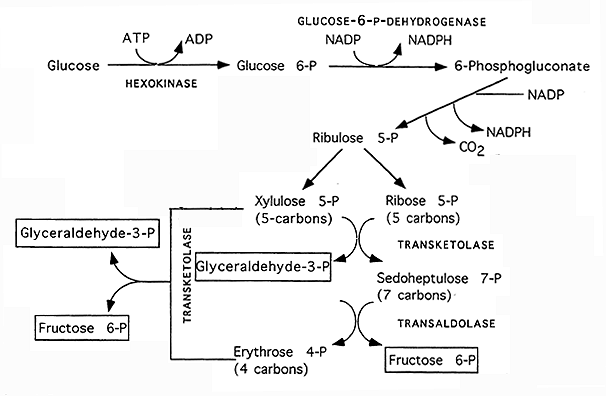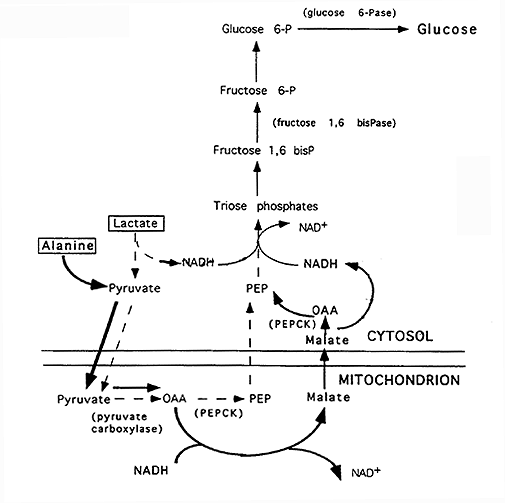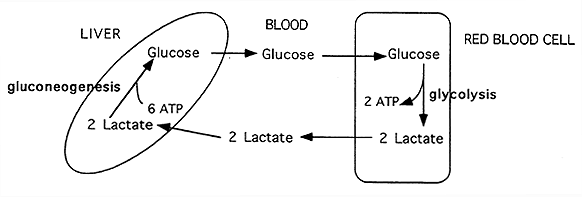
Pentose Phosphate Pathway / Gluconeogenesis
Pentose Phosphate Pathway:
-Source of NADPH (reductive synthesis, maintainence of glutathione in the reduced state), pentoses for nucleic acid synthesis, interconversion of pentoses with hexoses and trioses.

Oxidative Branch:
Glucose-6-phosphate ----> 6-Phosphogluconate ----> Ribulose-5-phosphate ----> Ribose-5-phosphate
Produces: 2 NADPH
Non-Oxidative Branch:
Ribose-5-phosphate ----> ----> Glyceraldehyde-3-phosphate + Fructose-6-phosphate
Produces:
Ribose-5-phosphate for nucleic acid synthesis.
Interconverts pentoses, hexoses and trioses.
Meeting Cellular Needs:
[1] When the requirement for Ribose-5-phosphate exceeds the need for NADPH
(a) Non-Oxidative Branch: reversed to produce Ribose-5-phosphate (nucleic acid precursor)
(b) Oxidative Branch: shut-down, no NADPH production
[2] When the requirement for NADPH exceeds the need for Ribose-5-phosphate
(a) Oxidative Branch: will be activated
(b) Non-Oxidative Branch: Ribose-5-phosphate will be converted to Glyceraldehyde-3- phosphate and Fructose-6-phosphate which will enter the glycolytic pathway for metabolism to pyruvate (this eliminates "feedback" inhibition by Ribose-5- phosphate which would inactivate the Oxidative Branch).
[3] When a balanced requirement for NADPH and Ribose-5-phosphate must be met
(a) Oxidative Branch: activated
(b) Non-Oxidative Branch: inactivated (Ribose-5-phosphate is not metabolized)
Glutathione: Tripeptide (Glu-Cys-Gly)
Glutathione Reduced: Glu-Cys(SH)-Gly
Glutathione Oxidized:
Glu-Cys-Gly
Glu-Cys-Gly
Glutathione Reductase:
Glutathioneoxidized + NADPH + H+ ----------------> 2 Glutathionereduced + NADP+
Contains bound FAD which it uses to transfer electrons from NADPH to Glutathioneoxidized
Glutathione Peroxidase:
2 Glutathionereduced + H2O2 ---------------------> Glutathioneoxidized + 2 H2O
Glutathionereduced: removes peroxides maintaining RBC membrane integrity and preventing hemolytic anemia.
Gluconeogensis:

Pyruvate Carboxylase: Pyruvate ---------> OAA
Requires biotin as a prosthetic group to carry CO2.
Requires ATP.
Activated: by acetyl CoA in concert with the inhibition of Pyruvate DH (PDH).
Phosphoenolpyruvate Carboxykinase (PEPCK): OAA ------------> PEP
"Rate -Limiting", commited step.
Requires GTP.
Induced during starvation.
Fructose 1,6-bisphosphatase: (Fructose-1,6-bisphosphate ------> Fructose-6-phosphate + Pi)
Can form a futile cycle with phosphofructokinase-1 (PFK-1)
Fructose-6-phosphate + ATP ------> Fructose-1,6-bisphosphate + ADP
The two enzymes are reciprocally regulated or ATP would be lost without energy conservation.
Glucose-6-Phosphatase: (Glucose-6-phosphate ------> Glucose)
Can form a second futile cycle with hexokinase/glucokinase
Glucose + ATP --------> Glucose-6-phosphate + ADP
The two enzymes are reciprocally regulated or ATP would be lost without energy conservation.
Unique to tissues producing glucose, i.e. liver and kidney.
Glucose-6-phosphate produced from the gluconeogenic pathway is transported to the ER for dephosphorylation.
Glucose and Pi are returned to the cytosol.
Glucose is exported to the blood and Pi remains in the cell.
Lactate as a Precursor: ~40% contribution
Derived from RBC's or from muscle during exercise.

Shows an interrelationship between liver and RBC's.
This cycle provides a means for localized ATP production. However, as a consequence of gluconeogenesis there is an overall NET LOSS of ATP in the body.
Alanine as a Precursor: ~25% contribution
Alanine is converted to pyruvate via alanine aminotransferase.
The Alanine Cycle (Glucose-Alanine Cycle):

Shows an interrelationship between liver and muscle.
Again, this cycle provides a means for localized ATP production. However, as a consequence of gluconeogenesis there is an overall NET LOSS of ATP in the body.
Glycerol as a Precursor: ~10% contribution
Produced from the breakdown of triacylglycerols in adipose tissue.
Glycerol ------> -------> DHAP, involves only enzymatic reactions in the cytosol.
© Dr. Noel Sturm 2014